|
Lancia, one
of the most famous and evocative of all the major automotive
brand names, was founded exactly 100 years ago today. To
celebrate this milestone Italiaspeed today starts an
exclusive 15 part history of Lancia.
Every once in a while, a historical figure emerges, who is
adjudged to have attained great stature in their chosen
field. It is a select enough group, but it is rarer still
that history judges them to have been somehow preordained to
pursue a certain destiny in life. Be it in politics, the
arts, science, or industry, these figures possess a
combination of talent, determination, single-mindedness and
leadership which suggests that they were placed on this
earth purely to achieve greatness in the fields in which
they excelled. In the formative years of the automobile
industry, a number of such figures left their mark, many of
their names still prominent on any suburban high
street. Nevertheless, even in this company, the name of
Vincenzo Lancia stands tall. An extraordinary man by any
measure, his constant quest to think outside the box, and
marry the orthodox with the radical, shaped the ethos of the
company he formed on this day in 1906. Throughout the last
hundred years, this philosophy has formed the groundwork for
Lancia’s legendary reputation of innovation (underlined by
hundreds of patents filed over the years), intertwined with
luxury, style and excellent performance.
Born on August
24, 1881 in Fobello, Val Sesia, Italy, Vincenzo was the
youngest of four children and the son of Cavalier Giuseppe
Lancia. The family was quite well-to-do, with Vincenzo’s
father having made his fortune in the preserved food
industry. This allowed them to spend the summer in their
villa in Fobello and the rest of the year in Turin, in a
property they owned in corso Vittorio Emanuele. Cavalier
Lancia had already mapped out the future for each of his
four children: Giovanni, Arturo, Maria and Vincenzo, who was
affectionately known as ‘Censin’. Vincenzo was earmarked to
become a solicitor.
At school,
however, ‘Censin’ proved to be a disaster. He was certainly
bright enough, but he simply couldn’t apply himself in his
studies. He was lazy and easily distracted, and eventually
his father reluctantly gave up on the idea of making a
lawyer of him. Instead, at the age of twelve, he was sent
off to college in the hope that he would at least gain a
diploma in accounting.
The young
Vincenzo was distracted from his studies, however, by the
workshop opened by the Ceirano brothers in the yard of the
family home. They built and sold bicycles under the name of
Welleyes, as English names had more clout with the public at
the time. Censin was a regular visitor to the Ceirano
workshop and before long he became a novice mechanic. When
the two brothers eventually started work on their first
automobiles, the young Vincenzo was fascinated by
engines. He left school and succeeded in obtaining his
father’s permission to go to work for the Ceirano
workshop. He was taken on as an accountant (seemingly at the
insistence of his father, who considered the position of
accountant to be slightly less demeaning than that of
mechanic), but instead of working on the company’s books, he
busied himself repairing engines.
In 1899, having
secured financial backing, the Ceirano brothers began
producing a small car designed by the engineer Aristide
Faccioli. The Welleyes automobile was a great success, but
the Ceirano brothers simply couldn’t keep up with demand. In
July of that year, they accepted Giovanni Agnelli’s offer,
and for the sum of thirty thousand lire they sold their
entire plant and the patents for the Welleyes car, which
would soon be the basis for the Fiat 3.5 HP. Lancia, then 18
years old, was taken on by Fiat as a test driver, as was
Felice Nazzaro, who had recently joined the company.
In its early
years, Fiat took active part in competitions, with Lancia
and Nazzaro behind the wheel. Nazzaro was a real ‘stylist’
when driving. Lancia, on the other hand, was impetuous, but
also tended to be quicker, whenever he wasn’t hit by
mechanical failure. It was in this role that he met and
befriended Claudio Fogolin, who joined F.I.A.T. in 1904 as
racing driver and engineer.
Lancia had
carved out a promising impending career as one of the great
racing drivers of his period with a number of impressive
drives throughout 1905, with his dedication, talent and
fantastic speed marking him out. However, in 1906, Vincenzo
took the decision which would shape the rest of his life and
automotive history. Following the Vanderbilt Cup in America
in October of that year, Lancia returned to Italy and
resigned his post as a racing driver for F.I.A.T., on the
basis that he no longer saw his own future in motor racing.
A few weeks later, on November 29, Lancia and Company Spa
was incorporated, with Vincenzo and Fogolin holding equal
stakes in the new enterprise. At the time, Lancia was 25
years old. Although he would continue his racing activities
for a couple of years, he was entering a new phase in his
life, one which would occupy him until his passing at the
tragically young age of 56.
The venture,
however, got off to an inauspicious start. The company’s
original premises were a small factory rented from Matteo
Ceirano, who had found the building too small for his
expanding Itala company. Sadly for the partners, the
building, along with its contents (including a prototype,
patterns, drawings and tools) was destroyed in February 1907
by a fire, started when an oil lamp overturned. According to
Nigel Trow in The Shield and Flag, it was, “one of
the few times (Maria Lancia) had seen her brother in tears.”
If Vincenzo was
deterred, however, it was only temporarily, as he started
work on reconstruction only a couple of days later. After
rebuilding the factory, it was decided to abandon the first
prototype in favour of a new design, the Tipo 51 ‘18-24 h.p.’,
which would retrospectively come to be known as the Alpha.
Built along largely conventional lines, but executed with a
deal of finesse, the Tipo 51 nonetheless incorporated a
number of noteworthy technical advances. These included the
forward positioning of the gearbox, mounted to the
crankcase, at a time when most gearboxes were placed a
significant distance from the engine. Careful attention to
detail in considering load points, cross-members and the
positioning of the engine and gearbox also allowed a very
lightweight and stiff chassis compared with the opposition.
Mechanically,
innovations included a 2543cc side-valve four-cylinder
engine which was shaft-driven (rather than the usual chain)
and revved to 1,450 rpm – very high by the standards of the
day, when most other engines would struggle to reach 1,000
rpm. Later development, meanwhile, would eventually see the
engine developing 28 hp at 1800 rpm. It also featured an
unusual twin-jet carburettor designed by Fogolin, as well as
a patented oil lubrication system penned by Lancia (via a
rotating force-fed oil pump). These features would also be
found on the 1908 Tipo 53 (Dialpha), which boasted a
six-cylinder engine, obtained by adding two pots to the
Alpha’s four-cylinder unit. One of the first six-cylinder
cars to be produced, the Dialpha could hit 110 km/h, making
it one of the best-performing cars of its day, but only 23
examples were produced.
Although a
prototype was prepared as early as September 1907, a mere
seven months after the factory fire, Lancia had waited a
further four months, until the 1908 Turin Salon, to unveil
the Alpha. By the time production stopped in the summer of
1909, 108 examples had been built. It was replaced by the
Tipo 54 (Beta – although as with all Lancias up to the
Kappa, this is a retrospective name, applied after 1919 when
Lancia adopted the practice of naming its cars after Greek
letters). In essence, the Beta was an extensive development
of the Alpha, with a new monobloc engine design, displacing
3119cc, generating 34 hp at 1500 rpm. It lasted until 1910,
by which time 150 cars were made. The Beta was, in turn,
replaced by the 1910 Gamma, which represented another steady
evolution. Capacity was increased once again, the existing
engine being bored out to 3456cc, lifting power to 40 bhp,
while short wheelbase cars with longer stroke (4712cc)
engines were frequently used in various competition events.
|
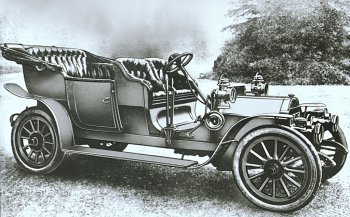 |
|
Built along largely conventional lines, but executed
with a deal of finesse, the Tipo 51 nonetheless
incorporated a number of noteworthy technical
advances. These included the forward positioning of
the gearbox, mounted to the crankcase, at a time
when most gearboxes were placed a significant
distance from the engine. |
|
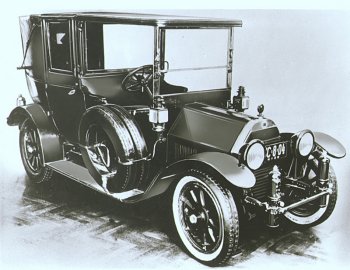 |
|
The 1910 Gamma replaced the Beta, representing a
steady technical evolution over its predecessor.
Power was raised to 40 bhp from the new 3.5-litre
engine. |
|
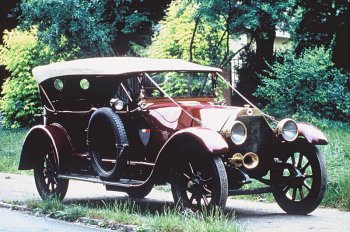
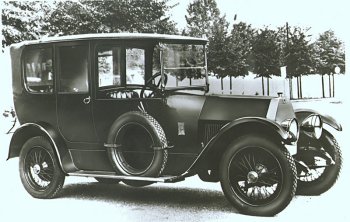 |
|
The Theta was a great
success for Lancia both domestically and in
international markets, with around 1700 units built
in a seven-year period. Described as, "the
definitive four-cylinder side-valve Lancia", it also
found a ready role in a wide variety of military
applications. |
|
|
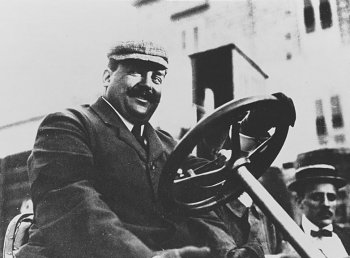 |
|
Racing driver Vincenzo
Lancia founded the Lancia marque on this day in 1906
in partnership with friend and engineer Claudio
Fogolin. |
|
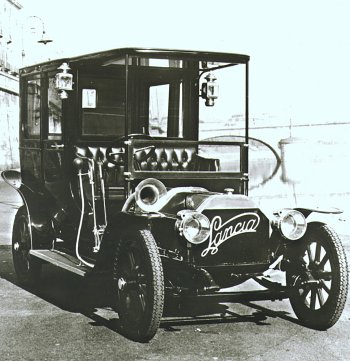 |
|
The Lancia Tipo 51,
retrospectively known as the Alpha, incorporated a
number of original technical solutions, commencing
Lancia’s proud reputation for innovation intertwined
with luxury, style, quality and excellent
performance. By the time production stopped in the summer
of 1909, 108 examples had been built. |
|
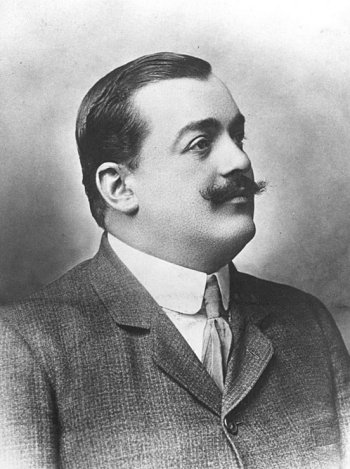 |
|
An extraordinary man by any measure, Vincenzo
Lancia's constant quest to think outside the box,
and marry the orthodox with the radical, shaped the
ethos of the company he formed on this day in 1906. |
|
|
Meanwhile, changes on the company side were afoot. The
original factory on the Via Ormea was succumbing
to spatial pressures, so in addition to enlarging it, the
company had also built a
second factory in the Corso
Dante to produce the Gamma. However, even this proved
inadequate, and so Lancia and Fogolin bought the redundant
Fides Brasier plant on the Via Monginevro in the spring of
1910 and moved the original workshops in the Via Ormea
there, with the first cars to emerge from the new factory
the Delta and Epsilon in January 1911. At the same time,
Lancia took the decision to adopt a new logo. Prior to 1911,
the marque’s cars had carried a simple brass plate with the
legend ‘Lancia & C.’, but to celebrate the factory’s opening
a new logo was designed by Lancia’s long-time friend Count
Biscaretti di Ruffia.
The twelve
months immediately following the opening of the new factory
were busy, with three new models – the Gamma’s successor,
the Tipo 56 (‘Delta’, plus a high performance version dubbed
the Bidelta), a long wheelbase version known as the Tipo 58
(Epsilon), and a short-wheelbase variation, called the Tipo
60 (Eta). The chassis remained a carryover from the Gamma,
itself fundamentally unchanged from the Beta, but the engine
had been stroked to 4.1 litres (4080cc) for the Delta and
Epsilon, with a further enlargement to 5 litres doing
service in the Eta.
The
following year, Lancia introduced the 15 h.p. (Zeta) – a car
whose technical innovations are generally overlooked. It was
powered by a new 2614cc four-cylinder engine, notable for
its very short length. This characteristic was made possible
by a new method of mounting the crankshaft, and whilst rated
at 15 hp, the reality was in fact closer to 30 bhp at 1800
rpm. Technical highlights included a water-driven cooling
fan, a special design of spring-mounted clutch, and a
four-speed gearbox with duplex direct drive on the top two
gears mounted at the rear, along with the
differential. However, although in regular production for a
number of years, sales were extremely poor, with only 34
examples sold.
It was left to the Tipo 61 of 1913, the
‘Theta’, to compensate for this failure, described by Trow
as, “the definitive four-cylinder side-valve Lancia.” Using
the 4942cc engine of the commercial/military 1Z, in this
guise developing 70 bhp, the Theta had a similar chassis to
the Delta. Innovations included a rake-adjustable steering
wheel with three positions, while a full range of built-in
electrical equipment, including full lighting, Rushmore
dynamo, electric starter and horn was made available as
standardised installation for the first time by a European
manufacturer. Around 1700 units were
built between 1913 and 1919,
and it was also successful in export markets such as Britain
and the United States.
In the meantime,
Lancia had been making progress on a new generation of V
engines. Prior to the outbreak of war, work had begun on an
all-new 60° V8 engine, narrow compared with the more usual
90° for such a layout, and a patent was filed on this design
just prior to Italy’s entry to the war in May 1915. However,
it remained stillborn as all work was devoted to military
purposes, with the Theta in particular finding a ready role
as the basis for barrage-balloon carriers, staff cars,
ambulances, gun tenders and even armoured cars. Other
vehicles produced for the military included the
aforementioned 1Z, Jota and Djota, all powered by the same
70 bhp, 4.9-litre four-cylinder engine found in the Theta.
Instead,
Lancia’s first V design was a huge 38-litre, 52° V12
designed for aircraft. Featuring overhead cams for the first
time on a Lancia engine, this beast was rated at 580 bhp at
1600 rpm when it was built in 1917, with incremental
improvements increasing this to 600 bhp at 1700 rpm by the
following year. The engine did not go into production and
was never used in action as by the time it was ready, the
war had ended. Nevertheless, the experience, especially of
the advantages of narrow-angle V engines, had deeply
influenced Vincenzo.
The result would
be seen following the cessation of hostilities, when at the
1919 Paris Salon Lancia unveiled the 7.8-litre (7837cc) 150
h.p. V12, exceptional for its extremely narrow vee angle of
22°. Such was its compactness, in the words of one
journalist, it looked, “like a six with dual ignition.” It
was displayed in a bare chassis which also featured a novel
design of rear suspension designed to give an equally good
ride whether the car was loaded or empty, through a
combination of cantilever and semi-elliptic springs. Lancia
envisaged building 1500 or so examples at 50,000 lire
apiece, but soon realised this to be over-ambitious and
dropped the project.
Although
somewhat overshadowed, Lancia also displayed the Theta’s
replacement at the Paris show – a new 35 h.p., which came to
be known as Kappa. In principle, this was still much the
same as Lancia’s original 1907 model, but the design had
been refined to keep pace with technical advancements, with
Lancia
now claiming a top speed of 125 km/h. In many ways very
similar to the Theta, with carryover parts including the
brakes, suspension, steering and electrical components, the
main differences included larger tyres, a slightly longer
wheelbase, a detachable cylinder head and a new Zenith
carburettor, which replaced the previous Lancia design in
use until that time. Despite its cost (some $6000 for a
chassis in the United States), it was a commercial success
both at home and in export markets, with around 1800
examples produced in a three-year production run. However,
such traditional models were beginning to be left behind,
and in 1921 Lancia introduced the Dikappa, a sports tourer
version of the Kappa with an overhead valve version of the
four-cylinder engine developing 87 hp, giving it 125 km/h
capability. Dubbed the Tipo 64, the Dikappa shared the
Kappa’s chassis, but with aluminium panels on the wooden
frame. Around 160 units were produced in total until 1922.
A
further development of the theme, the Trikappa, was launched
in 1922. It was the fastest, most powerful Lancia produced
so far and represented the culmination of conservative
chassis for the company, but its real significance lay in
its brand-new 4.9-litre V8 engine, six years in the
making. The new motor was heavily based around the 50 hp
V12, and was, in effect, this engine minus four cylinders,
with a few other minor changes. Eventually, around 900 were
built in a production run lasting between 1922 and 1925.
Word got out, however, about a troublesome transmission
brake, and sales dived, with some 300 examples standing idle
at the company’s works at one point.
This represented a significant capital
investment tied up which Lancia could not afford, and the
immediate outlook at this stage was distinctly unpromising. Between
the company’s founding and the years immediately following
the First World War, Lancia’s production was thus primarily
dedicated to fast middle-class tourers, with a somewhat
conservative reputation, all of which in some way developed
the principles first seen in the Alpha. In 1921, however,
Lancia would reveal one of the most significant landmarks in
the history of the automobile. Representing the culmination
of a number of radical ideas in a single landmark technical
achievement, it would make Lancia famous, assure the future
of the company, and provide the basis of Vincenzo’s thinking
for the rest of his life. It would be dubbed the Lambda.
by Shant Fabricatorian
|
|
|
|
![]()
![]()